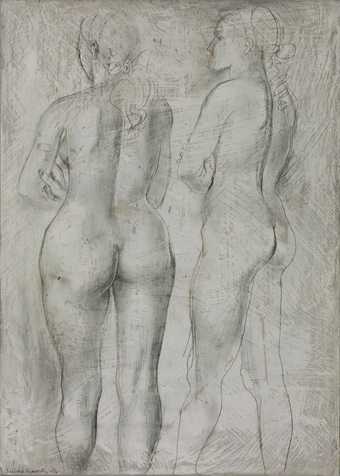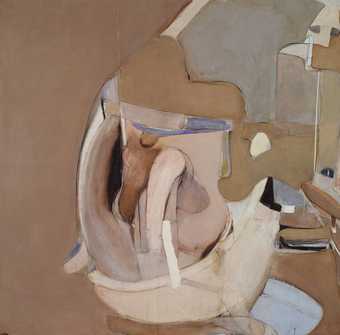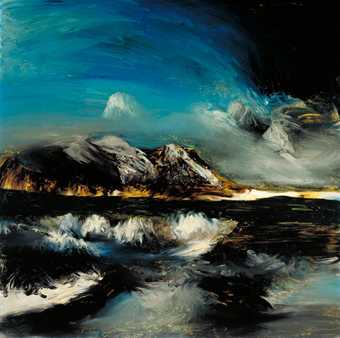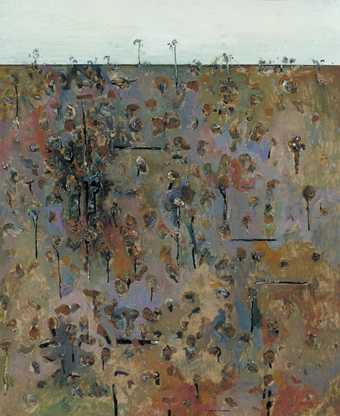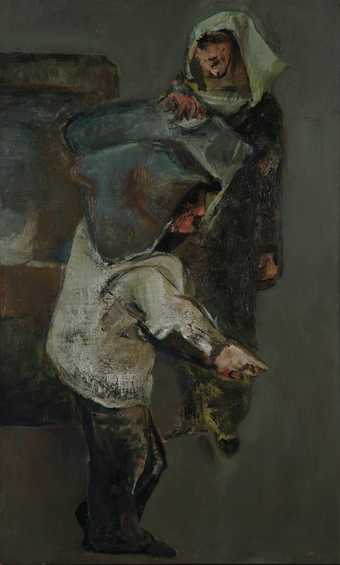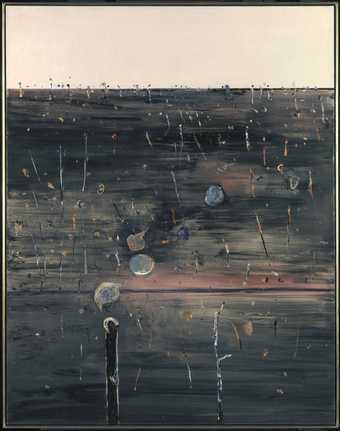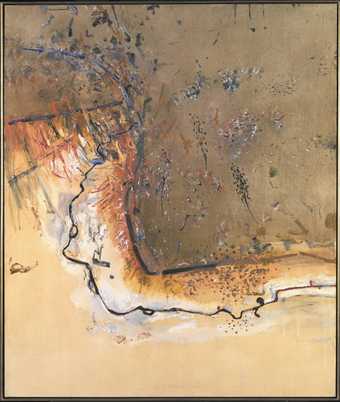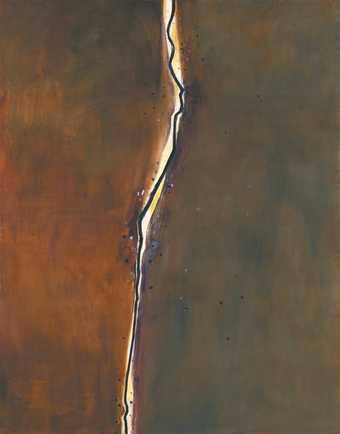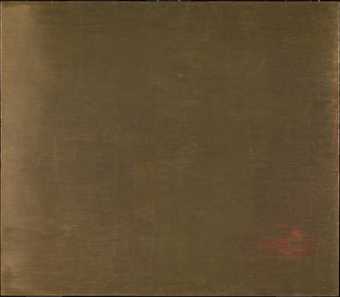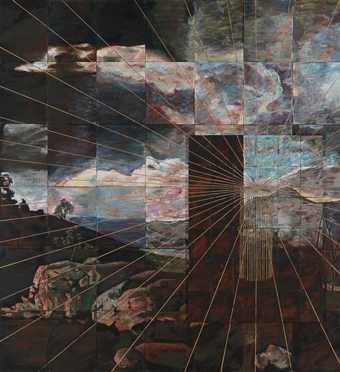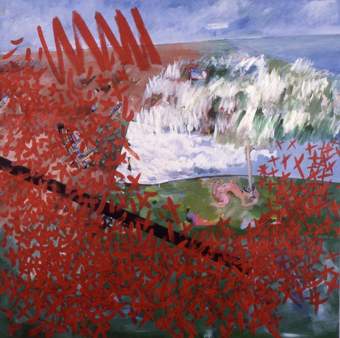
- Artist
- Ian Burn 1939 – 1993
- Medium
- Lacquer paint on plywood panel
- Dimensions
- Support: 1184 × 796 mm
- Collection
- Tate
- Acquisition
- Tate and the Museum of Contemporary Art Australia, with support from the Qantas Foundation 2015, purchased 2018
- Reference
- T15519
Summary
Blue Reflex 1966 is a portrait format monochrome blue painting on board. It followed a group of similarly blue monochrome paintings that had been painted using acrylic paint and a layering of glazes on stretched canvas. Burn wished to create a surface that would not be broken up either by the weave of the canvas or the irregularity of manually applied paint, and with the group of paintings that followed, of which Blue Reflex is one, he prepared ply-board with an epoxy resin before applying automobile lacquer with an airgun. The result was a painting that erased many traces of artistic gesture and achieved a uniformity of finish, but the use of automobile lacquer introduced a quality of reflection not apparent in his previous paintings that relied wholly on glaze for such effects. The choice to apply lacquer with an airgun gives the painting a character close to a manufactured object. Yet, although the quality of reflection draws attention away from the painting and towards its surface and what is reflected within it, the edges of the painting reveal its handmade materiality.
The quality of reflection in the painting signals the degree to which Burn’s work addressed the nature and conditions of perception, and with works such as Blue Reflex he created paintings that moved from the perceptual space of modernist art towards a conceptual space. Even so, at the time, Burn equated a conceptual space with the idealisations implicit within Kasimir Malevich’s non-objective painting (something he held in common with his friend and collaborator Mel Ramsden [born 1944]); in a contemporaneous notebook Burn wrote that ‘conceptual space exists only in awareness of, having no fixed externalisation … but is centralised, expanding in a field of awareness (the scope of this field is a reflection of the spectator’s personal awareness).’ (Ian Burn, ‘Notes 1966–7’, cited in Art Gallery of Western Australia 1992, p.43.) This idea of a conceptual space was key to the challenge that he and Ramsden made to modernist art as it was defined by the American critic Clement Greenberg – as medium specific, autonomous, self-referential and defined by its own conditionality. For them painting had instead to draw its material, content and criticality from the world in which it existed and acted within. In the case of Blue Reflex this was identified by the use of an industrial process to make something that was both painting and object (the airgun delivering a paint surface and Royal Blue colour commonly associated with American REO trucks), as much as in the quality of its reflective surface, or ‘reflex’.
The paintings that Burn made between 1966 and 1967 – like those made contemporaneously by Ramsden – emerge as a parody and critique of modernist painting, disrupting the blankness of the monochrome. Although the extreme abstraction and perceptual flatness of Blue Reflex chimes with modernist values at their furthest extent, its materials present the work with a degree of everyday fact and objecthood that oil paint on canvas could not. Furthermore, its reflective surface ensures that what is seen by the viewer is not solely the materials and surface of the work but that this is interrupted by the reflection of the environment around the painting. In this way the blankness of the monochrome becomes pictorial and subject to illusion in such a way as to dislocate modernist perception, so that the site of the painting and the movement of the beholder become key.
Burn subsequently concentrated not just on the reflective qualities revealed by Blue Reflex but articulated these in philosophical or theoretical texts that, through their questioning of the condition of art, increasingly took the place of painting. An early realisation of this approach was his Mirror Piece 1967 (Tate P80072), made not long after his arrival in New York. This consists of a mirror, the size and proportions of a regular bathroom mirror that has been additionally glazed and framed, as well as thirteen sheets of text and diagram, entitled ‘Notes for Mirror Reflexes’. These notes act as instruction for the construction of Mirror Piece but also analyse how it might be perceived, for instance how images reflected in the mirror are refracted through the layer of glass that glaze it; the notes also address its definition as art or bathroom mirror. The sheets of text and diagram were pasted on the wall beside the framed mirror and for Ramsden the moves described by Blue Reflex and Mirror Piece – from a reflective painting with reflective qualities to an everyday object and then to text about that object – were a crucial shift towards conceptual art:
this pulled the conversation into the work and the work into the conversation. The talk went up on the wall and he [Burn] was able to make more confident first-order claims for it. This instead of regarding the objects as furtive reminders of an unheard of almost forgotten conversation … The foregrounding of text and diagrams as ‘substantial’ work was new to me at the time, and it gave the ‘work’ a new home.
(Mel Ramsden, ‘Making art from a different place’, in Art Gallery of Western Australia 1992, p.15.)
Further reading
Charles Harrison and Fred Orton, A Provisional History of Art & Language, Paris 1982.
Ian Burn: Minimal–Conceptual Work 1965–1970, exhibition catalogue, Art Gallery of Western Australia, Perth 1992.
Robert Bailey, Art & Language International: Conceptual Art between Art Worlds, London 2016.
Andrew Wilson
November 2017
Does this text contain inaccurate information or language that you feel we should improve or change? We would like to hear from you.
You might like
-
Dame Barbara Hepworth Two Figures with Folded Arms
1947 -
Brett Whiteley Untitled Red Painting
1960 -
Brett Whiteley Woman in a Bath II
1963 -
Sir Sidney Nolan Antarctica
1964 -
Fred Williams Upwey Landscape
1964–5 -
Fred Williams The St George River
1960 -
Fred Williams Coal Delivery
1955 -
Fred Williams Burnt Landscape II (Bushfire Series)
1970 -
Fred Williams Beachscape, Erith Island II
1975 -
Fred Williams Dry Creek Bed, Werribee Gorge I
1977 -
Fred Williams Riverbed D
1981 -
Arthur Boyd Bride Drinking from a Creek
1960 -
Mathias Goeritz Message
c.1959 -
Imants Tillers Kangaroo Blank
1988 -
Vivienne Binns The Aftermath and the Ikon of Fear
1984–5

